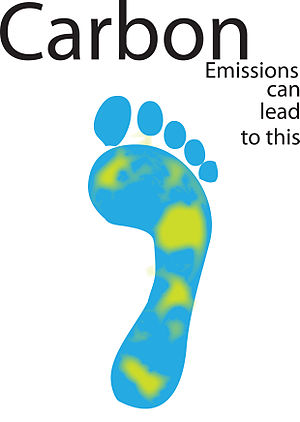
What is a Carbon Footprint?
The phrase is used often, but definitions of carbon footprint vary. A very long, detailed explanation is: “A measure of the total amount of carbon dioxide (CO2) and methane (CH4) emissions of a defined population, system or activity, considering all relevant sources, sinks and storage within the spatial and temporal boundary of the population, system or activity of interest. Calculated as carbon dioxide equivalent (CO2e) using the relevant 100-year global warming potential.” (Carbon Footprinting)
Carbon footprint is measured in tons of CO2 equivalent. This number is a metric measure that compares the emissions from different greenhouse gases based on their global warming potential. For example, the potential for methane over 100 years is 21. Therefore the emissions for one million metric tons of methane are equivalent to 21 million metric tons of carbon dioxide emissions. Carbon footprints can be generated by a person, family, building, organization, company, or country.
The average carbon footprint per household in the US is 48 tons CO2 equivalent per year. The global average is around 10 tons CO2 equivalent per year. The largest factors to this high carbon footprint are transportation, followed by housing, food, and goods. Of these factors, the largest contributor to carbon footprint is gasoline consumption. The most important part to remember is that for the average person, your carbon footprint is the total set of greenhouse gas emissions caused by your travels, purchases, and activities.
Removed from our daily lives, the largest hidden contributor to carbon footprint is the emissions generated by power sources. The United States has several techniques and fuels to supply electricity that each generates different amounts of carbon. Coal, oil, and natural gas understandably generate the highest amounts of CO2 equivalents per kilowatt hour. Nuclear, wind, and hydroelectric sources produce very little CO2 equivalents. In fact, wind and hydroelectric power only produce carbon emissions during construction and maintenance operations.
How can you reduce your carbon footprint? Consider the main categories:
Transportation:
- Commit to driving less.
- Consider purchase of a fuel efficient, hybrid, or electric vehicle.
- Even better – use public transportation.
Housing:
- Consider where your home’s electricity and heating come from, and investigate switching to a better source, such as geothermal.
- Increase home insulation for the winter and use fans instead of air condition during the summer.
Food:
- Buy local!
- Avoid red meat, dairy, and seafood products.
Goods:
- The larger the size of the product, the larger the footprint will be.
- Glass is worse than aluminum – aluminum is highly recyclable.
- Both glass and aluminum are preferable to plastic.
- Use your own containers, mugs, cups, and utensils instead of disposables.
- Consider purchasing used clothing.
What else can you do?
- Purchase carbon offsets that can be used to fund research into sustainable development.
- Purchase efficient equipment to reduce demand on energy sources.
- Use less water – shorter showers, smart irrigation, limited lawn watering and car washing.
Overall, be conscious of the energy and materials that go into your activities and try to adjust accordingly. Each step you take is one closer to a cleaner tomorrow.
By Alanna Scheinerman, Class of 2013
Related articles





